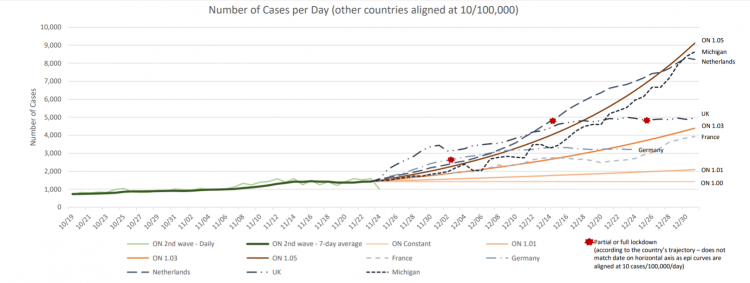
New modelling shows the province could see 9,000 daily new cases of COVID-19 with the number of patients in intensive care expected to hit 200 by the end of next month.
Posted Nov 27, 2020, 06:23AM EST
New modelling shows the province could see 9,000 daily new cases of COVID-19 with the number of patients in intensive care expected to hit 200 by the end of next month.
New provincial data show COVID-19 hospitalizations in Ontario went up more than 63 per cent over the last four weeks and that deaths in long-term care homes are rising, even though the number of cases among staff and residents appears to be flattening.
This is the first time new projections have been released since the province sent Toronto and Peel Region into lockdown earlier this week.
The report shows 70 per cent of new cases in Toronto, and 27 per cent of cases in Peel and Ottawa, cannot be linked to a source.
The modelling provides several scenarios for cases towards the end of the year.
If we stay stagnant, daily cases will remain around 1,500 by the end of the year. If the province sees one per cent growth, there will be just over 2,000 cases a day.
At three per cent growth, we will see 4,500 daily COVID-19 cases while at five per cent, the province will hit 9,000 cases by the end of December.

The previous modelling, released two weeks ago, showed Ontario could see as many as 6,500 new daily cases of COVID-19 by mid-December unless steps were taken to limit the spread of the virus.
It said the province would reach 2,500 new daily cases by that time if the growth rate was at three per cent, or 6,500 if the growth rate was at five per cent.
At the time, Dr. Adalsteinn Brown, one of the experts behind the projections, said a five per cent growth rate was “slightly optimistic.”
Health officials have also pointed out that some communities are being hit harder by the pandemic because of “long-standing structural factors that lead to a higher exposure to COVID-19.”
The modelling says a one-size-fits-all approach will not have the same impact on some communities, especially ones with a higher household density, higher proportion of essential workers and neighbourhoods with the lowest percentage of suitable housing.
The latest data were released shortly after the province announced it is starting voluntary COVID-19 testing for asymptomatic students, faculty and staff in regions with high rates of transmission.
The expanded testing will be provided for four weeks in schools in Toronto, Peel and York regions, and Ottawa. Those who show symptoms or have been exposed to a COVID-19 case should continue to stay home and get tested at an assessment centre, the province said.
The province first announced the program this summer but it had not yet taken effect.
Files from The Canadian Press were used in this report





